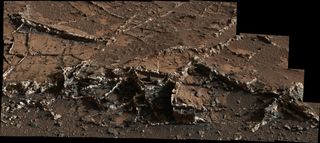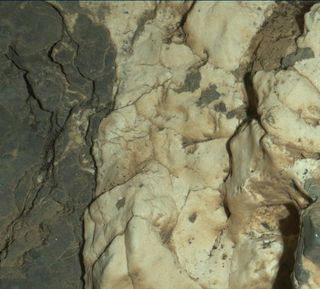
NASA's Curiosity rover has photographed some Martian rocks that bear a passing resemblance to a tasty frozen treat.
The rocks, which lie at a site dubbed Garden City near the base of Mars' 3.4-mile-high (5.5 kilometers) Mount Sharp, harbor ridges up to 2.5 inches (6 centimeters) tall that are composed of bright and dark mineral veins.
"Some of them look like ice-cream sandwiches: dark on both edges and white in the middle," Curiosity science team member Linda Kah of the University of Tennessee said in a statement. "These materials tell us about secondary fluids that were transported through the region after the host rock formed." [Latest Photos from NASA's Mars Rover Curiosity]
The car-size Curiosity rover touched down in August 2012, on a mission to determine if Mars could ever have supported microbial life. The rover found evidence of an ancient, habitable lake-and-stream system at a spot near its landing site called Yellowknife Bay.
The fluid movement responsible for the Garden City veins was likely more recent than the conditions that formed the Yellowknife Bay lake, which probably existed around 3.5 billion years ago.
"Mud that formed lake-bed mudstones Curiosity examined near its 2012 landing site and after reaching Mount Sharp must have dried and hardened before the fractures formed," NASA officials wrote in the statement. "The dark material that lines the fracture walls reflects an earlier episode of fluid flow than the white, calcium-sulfate-rich veins do, although both flows occurred after the cracks formed."
Mount Sharp has long been Curiosity's main science destination. Mission team members want the rover to climb up through the mountain's foothills, reading a history of Mars' changing environmental conditions as it goes.
Get the Space.com Newsletter
Breaking space news, the latest updates on rocket launches, skywatching events and more!

Curiosity reached the foot of Mount Sharp in September 2014. The six-wheeled robot then spent six months exploring the bottom layers of an outcrop called Pahrump Hills, drilling into three different rocks to collect samples for analysis.
The 1-ton rover suffered a brief short circuit in late February while transferring the powder from the last of these Pahrump Hills drilling operations from its robotic arm to the analytical instruments on its body. Engineers traced the short circuit to the percussive mechanism in Curiosity's arm-mounted drill, which hammers as well as rotates to bore into rock.
The Curiosity team is still working out a strategy for future drilling, NASA officials said. (The rover has not drilled any Garden City rocks.)
"We expect to use percussion as part of drilling in the future while we monitor whether shorts become more frequent," said Curiosity deputy project manager Steve Lee, of NASA's Jet Propulsion Laboratory in Pasadena, California.
Follow Mike Wall on Twitter @michaeldwall and Google+. Follow us @Spacedotcom, Facebook or Google+. Originally published on Space.com.
Join our Space Forums to keep talking space on the latest missions, night sky and more! And if you have a news tip, correction or comment, let us know at: community@space.com.

Michael Wall is a Senior Space Writer with Space.com and joined the team in 2010. He primarily covers exoplanets, spaceflight and military space, but has been known to dabble in the space art beat. His book about the search for alien life, "Out There," was published on Nov. 13, 2018. Before becoming a science writer, Michael worked as a herpetologist and wildlife biologist. He has a Ph.D. in evolutionary biology from the University of Sydney, Australia, a bachelor's degree from the University of Arizona, and a graduate certificate in science writing from the University of California, Santa Cruz. To find out what his latest project is, you can follow Michael on Twitter.
